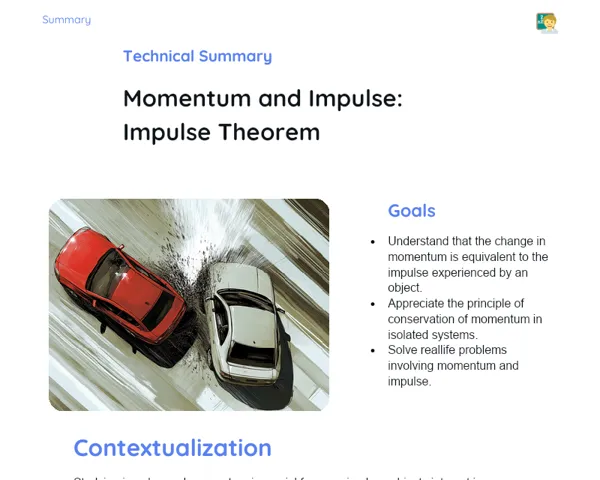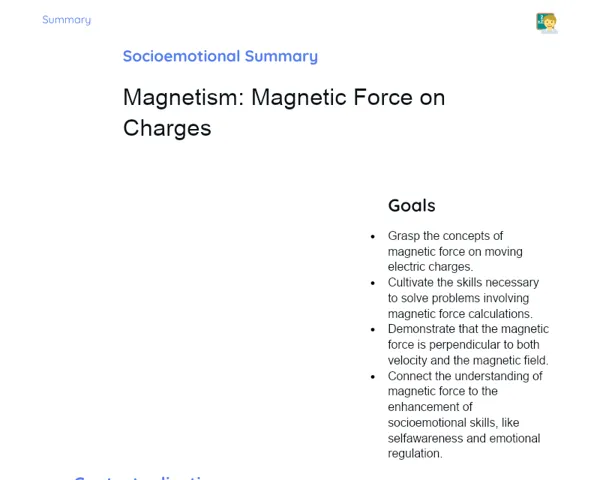Socioemotional Summary Conclusion
Goals
1. Understand how the speed of a wave relates to the material of the string.
2. Develop skills to calculate the speed of a wave in various types of strings.
3. Apply the concept of wave speed in practical, everyday scenarios.
4. Reflect on how different materials and tensions impact wave propagation.
Contextualization
Did you know that the music we enjoy is closely tied to the physics of waves? 🎸✨ When we play a string instrument like the guitar, the speed of the wave in the strings determines the sound we produce. Different materials, such as nylon or steel, play a crucial role in this speed, giving rise to distinctive sounds. By exploring this, we not only deepen our understanding of physics but also gain a greater appreciation for the science behind our daily interests and hobbies!
Exercising Your Knowledge
Definition of Wave
A wave is a disturbance that travels through a medium, transporting energy without moving the matter itself. So, when you see a wave moving along a string, the string doesn’t shift side to side; it’s the energy that’s in motion.
-
Disturbance: Essentially, a wave is a disturbance or temporary change that travels through a medium.
-
Propagation: The wave carries energy along the string without shifting the string's matter.
-
Energy vs Matter: It's vital to understand that waves transport energy, not matter, helping to distinguish wave phenomena from physical movements.
Components of the Wave
A wave consists of components like crest, trough, amplitude, wavelength, and frequency. These terms help us describe and categorize waves, making their behaviors easier to grasp.
-
Crest: The highest point of the wave, where the disturbance is maximum.
-
Trough: The lowest point of the wave, where the disturbance is minimum.
-
Amplitude: The distance between the equilibrium line and the crest (or trough). Amplitude indicates the wave’s energy.
-
Wavelength: The distance between two consecutive crests (or troughs), dictating the wave's periodicity.
-
Frequency: The number of waves passing through a point within a specific timeframe. Higher frequency means more waves in less time.
Wave Speed Equation
The fundamental equation to calculate the speed of a wave on a string is v = √(T/μ), where v represents speed, T is the tension in the string, and μ is the linear mass density. This equation clearly shows how various physical factors affect wave speed.
-
Tension (T): The force acting along the string. More tension results in faster wave speed.
-
Linear Mass Density (μ): The mass for each unit length of the string. Heavier strings slow down wave speed.
-
Interrelationships: Grasping how tension and linear mass density interact enables us to predict and control wave speeds in different practical scenarios.
Key Terms
-
Wave: A disturbance that carries energy without moving matter.
-
Crest: The highest point of the wave.
-
Trough: The lowest point of the wave.
-
Amplitude: Distance from the equilibrium line to the crest/trough.
-
Wavelength: Distance between two consecutive crests or troughs.
-
Frequency: Number of waves passing a point in a specific time.
-
Tension (T): Force along the string.
-
Linear Mass Density (μ): Mass per unit length of the string.
For Reflection
-
How do the various components of a wave relate to your daily experiences, such as playing an instrument or observing waves in water?
-
In what ways can understanding wave properties aid you in making informed choices, like selecting materials for school projects or solving everyday issues?
-
How did you handle your emotions during the lab activity? What techniques did you employ to remain calm and work well with your group?
Important Conclusions
-
We discovered how the speed of a wave is influenced by the string material.
-
We learned to calculate the wave speed for different string types using v = √(T/μ).
-
We reflected on the practical implications of this knowledge in everyday contexts, such as music and other physical phenomena.
-
We developed essential socio-emotional skills, including teamwork and emotional regulation during challenging tasks.
Impacts on Society
Grasping waves and their characteristics significantly influences our daily lives. For instance, while playing a musical instrument, we apply our understanding of waves to produce harmonious sounds and melodies. The string's tension and material affect sound quality, and knowing these principles helps musicians refine their performance and instrument choices. 🌟🎶 Moreover, the physics of waves extends beyond music. It's pivotal in domains like telecommunications and medical technology. In telecommunications, waves transmit signals for radio, television, and internet, connecting people globally. In medical tech, comprehending ultrasonic waves enables non-invasive procedures like ultrasounds, yielding more accurate and secure patient diagnoses. 🚀🩺
Dealing with Emotions
I recommend doing a self-reflection exercise at home using the RULER method. First, identify your emotions while studying this topic: did you feel confused, curious, or excited? Recognize what caused those feelings; was it the complexity of the content or group dynamics? Accurately label your emotions and express them appropriately. For instance, if you felt upset, share it constructively with your classmates or family. Lastly, manage your emotions by finding strategies like taking breaks to refresh, practicing deep breathing, or engaging in group discussions to clear doubts. This exercise will help you effectively handle your emotions while enhancing your emotional intelligence. 😊💪
Study Tips
-
Review core concepts of waves and their properties using online videos and animations for better visualization.
-
Practice solving problems related to wave speed on various strings to solidify understanding of v = √(T/μ).
-
Conduct small home experiments using different strings and measuring tension, then compare your findings with theoretical predictions for a more interactive learning experience.



